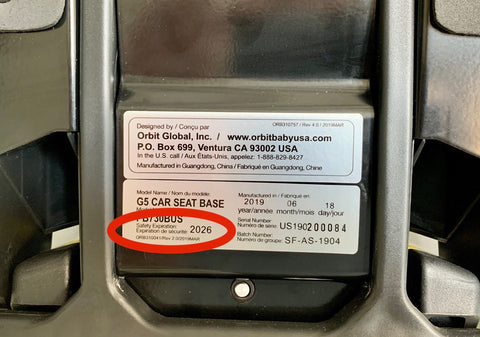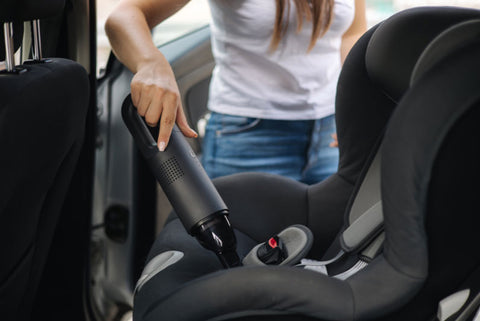How Long are Car Seats Good for?
Car seat expiry is an absolute bummer as it takes most new parents by surprise. Many new parents wonder about their car seat expiry date and keep wondering “Do car seats expire?” and the answer is yes. Like every other item or product in the world, car seats do have a lifespan, and today, we are going to give you a detailed explanation of how and why expiry happens, as well as a few tips on maintaining yours to keep it in good shape for a decent amount of time.
Why do Car Seats Expire?
Every product in the world has a lifespan predetermined by the manufacturer, which is how they are able to predict the exact expiry date of their product and write it on the label to inform consumers about when they should throw it away. Usually, the typical lifespan of an infant car seat is between 6 to 10 years from the date of manufacture, and here are a few reasons why car seat expiration happens.
Material Degradation:
No matter the brand, car seats are generally made from materials like plastic, metal, and fabric, which can degrade and weaken over time, meaning that car seat expiration is inevitable. This decrease in quality makes the car seat less capable of protecting your baby properly, and once this decrease reaches a certain point, the car seat becomes unsafe for usage. This degradation, which leads to car seat expiry, happens due to environmental factors like extreme temperatures, excessive exposure to sunlight, and general wear and tear from frequent usage.
Safety Standards and Regulations:
As new technologies and testing methods become available, essential things like safety standards evolve by the minute. Meaning, that your old car seat has to expire at some point in time to make room for newer safer seats made according to updated safety standards, rather than the outdated ones of your old seat. Companies are constantly updating their designs to meet the latest safety standards and to try and add more convenient features along the way, which makes newer seats not only safer but more practical. So in short, a car seat expiry date is a must.
Technology and Design Advancements:
Car seat designers are always coming up with new methods and technologies to provide parents with more comfort and safety. For instance, modern car seats feature more effective energy-absorbing materials, simpler installation systems, and improved side-impact protection, among other cutting-edge features and designs that all serve the purpose of improving safety and ease of use. This is why using an older car seat means potentially putting your child at a higher risk of injury in a car accident, which is why we put an expiry date on car seats.
Product Integrity:
Due to frequent, almost daily, use, the mechanisms and overall components of your baby's car seat start to wear out. Things like buckles, latches, and harness systems become less reliable and more susceptible to failure over time. Check your car seat expiry date, If it has either passed it or is near it, that means it's time to let it go and go have fun shopping for a new one.
How to Check Car Seat Expiry Date:
There are many steps you can follow to check for car seat expiration. Here are a few good examples:

Check the Manufacturer's Label:
Look around your car seat for a sticker or a label, it usually has the car seat expiry date and manufacture date written on it.
Find the Date of Manufacture:
Usually, you can find this date on the same label or sticker next to where the expiry date is listed. It could be labeled as MFG date or manufacture date.
Contact the Manufacturer:
If you looked all around the car seat and couldn't find any labels or stickers anywhere, or just have doubts about the specific lifespan of your seat, you can contact the manufacturer directly and ask them about anything you want. All you need to do is provide them with your car seat's model number, and they should be able to pinpoint the exact expiration date for you.
You Can Also Check The Manual for Car Seat Expiry Date:
Being one of the only sources that has everything related to the product, the manual should have some information about your car seat expiry date. If you do have it, go through it thoroughly and you should be able to find some answers to your questions.
Check the Car Seat for Wear and Tear:
It's very important to regularly check your car seat for any indications of wear and tear, corrosion, or degradation. Regardless of the car seat expiry date, if you see a decline in quality that you would consider to be a bit excessive, it's time to replace it.
Register Your Car Seat:
Safety recalls and updates happen all the time, so to keep yourself in the safe zone, it's better to register your baby's car seat with the manufacturer to stay informed about anything important. In addition, it might serve as a helpful reminder of the car seat expiry date and when to replace it.
How to Keep Your Baby’s Car Seat in Good Shape:
While car seat expiration is inevitable, maintaining your little one's car seat can guarantee that it will function properly for a longer period. The following advice will help you keep your baby’s car seat in good shape for a decent amount of time:
Read and Follow the Manufacturer's Instructions:
Before using or installing your baby's car seat, you should read the instruction manual thoroughly to ensure you know how to maintain and properly use it. This manual which people usually take for granted includes important information on how to install the car seat, adjust the harness straps, clean the car seat, and use the car seat safely. Following these instructions won't prevent car seat expiration, but it will help to ensure the safety and effectiveness of the car seat in protecting your child.
Regular Cleaning:
Car seat expiration has a lot to do with dirt and other external factors that eat up the materials alive. So, make sure to maintain a regular cleaning routine for your seat to keep it in good condition for as long as possible. Use a gentle detergent and avoid bleach or fabric softeners when cleaning the fabric covers, as they can damage the fabric and weaken the straps. As for the plastic, metal, and other non-fabric parts, use a damp cloth and some soap to clean any dirt, stains, or spills. You won't dodge car seat expiry, but this routine will be worth it in many other ways.
Check for Wear and Tear:
Frayed straps, cracked plastic, or broken parts can all be signs of car seat expiry. Regularly check for such signs as they could mean that your little one isn't as safe in their seat as you might think. To keep the car seat secure and intact, replace any worn-out or damaged pieces as soon as possible. The majority of manufacturers provide appropriate replacement parts for their car seats. But, it's honestly better to just go for a new car seat to completely ensure your baby's safety.
Avoid Extreme Temperatures:
Extreme temperatures can speed up the process of car seat expiration because high temperatures can cause the materials to degrade and weaken much quicker than they normally would. Try to always keep your little one's car seat somewhere cool and dry to protect it from harsh weather conditions and temperatures that could shorten its life and compromise its safety.
How Can Kido Bebe Help?
At Kido Bebe, we provide the best of every product. We have perfected a wide range of collections of baby essentials from reputable brands to ensure that your little one gets the quality products they deserve, and so as the moms!
If car seat expiry is what you fear most, check our infant car seat collections to get the car seat that's guaranteed to protect your baby for as long as possible.
FAQs:
Parents, especially new ones, always have a lot of questions to ask. We try our best to answer as much as we can in every blog. Let’s answer the frequently asked questions about today’s topic.
When do Car Seats Expire?
In general, a car seat expiry date ranges between six and ten years from the date of manufacture. As we've covered, there are several reasons why they expire, including as normal wear and tear, regulatory changes, recalls, and limitations in the manufacturer's testing.
What to do with Expired Car Seat?
When a car seat expiry date is due, the best thing to do is to take it apart, sort out the materials, and then put each of them in the proper recycling bin. You can also try to donate it, or take it to places that specialize in recycling such products.
Which Side of The Car is Safest for a Baby?
The center rear seat is the ideal location for your baby's car seat, as all the experts seem to agree. The primary goal of that is to keep the youngster as far away from the side doors as possible, which will better protect them from sideways impacts.
In Conclusion:
Car seat expiration is inevitable, but with enough care, you can make the most out of your car seat until the very end of its lifespan. Always remember to check for any signs of wear and tear or any other signs of car seat expiry to keep your baby safe and away from any potential accidents.




